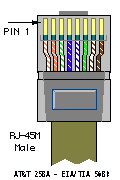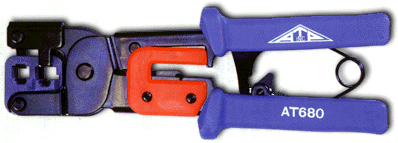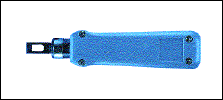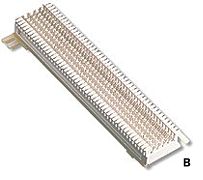Category 5 cable is used for both telephone wiring and data network wiring. It exists in two very different types: Solid conductor and stranded conductor.
Also, any of these types tend to be available with PVC jackets or Teflon jackets.
Category 2 is a shielded twisted pair cable, which was mostly used for token ring.
Category 3 is shielded twisted pair approved for 10 Mbps ethernet.
Category 4 I don't know.
Category 5 is also unshielded twisted pair with more twists per foot, certified for 100 Mbps ethernet applications.
Eventually, there will be a standard for 622 Mbps ATM and for gigabit ethernet use. Some cable manufacturers are producing cable for these applications, which they call "enhanced category 5".
+-----------+ | 1 white/orange | 2 orange | 3 white/green |------+ 4 blue (cable sticks out this way) |------+ 5 white/blue | 6 green | 7 white/brown | 8 brown +-----------+
 Of course it is easier to see the wires from the other side of the plug.
(Image taken from
Cabletron's support
site.)
Of course it is easier to see the wires from the other side of the plug.
(Image taken from
Cabletron's support
site.)
Note that there are at least 3 versions of the connector, which look exactly alike to the naked eye, and are generally not marked clearly. If you use the wrong connector, it will tend not to work: Your connections will be flaky and need to be seated just right, then wiggle out of place when you turn your back. These variations are:
 These tools are available in a variety of price ranges; generally
the better tools are more expensive, and they are worth the price.
The picture is Allen Tel model AT680, which is about as good as it
gets. The ratchet mechanism ensures that you will get the connectors
fully engaged before it lets you release.
These tools are available in a variety of price ranges; generally
the better tools are more expensive, and they are worth the price.
The picture is Allen Tel model AT680, which is about as good as it
gets. The ratchet mechanism ensures that you will get the connectors
fully engaged before it lets you release.

 When attaching in-the-wall wiring to patch panels and wall-mounte jacks,
the connector is usually of a type where the wire is squeezed into
a slotted post, which pierces the insulation on the wire.
The proper tool for this is a punch-down tool, which slides over the
post and ensures that the wire gets to the bottom of the slot.
There are two types of posts. The 110-type is used in wall jacks and
in connector blocks used only for data.
When attaching in-the-wall wiring to patch panels and wall-mounte jacks,
the connector is usually of a type where the wire is squeezed into
a slotted post, which pierces the insulation on the wire.
The proper tool for this is a punch-down tool, which slides over the
post and ensures that the wire gets to the bottom of the slot.
There are two types of posts. The 110-type is used in wall jacks and
in connector blocks used only for data.

 The 66-type connector block is the traditional cross-connect block
used in telephone rooms, and has been extensively used for data as well.
It is not as compact as the 110 connector block.
The 66-type connector block is the traditional cross-connect block
used in telephone rooms, and has been extensively used for data as well.
It is not as compact as the 110 connector block.
 The 66 block has 50 rows, each with 4 slotted pins.
For telephony, it is common to use a version where each row is broken
in the middle, so that there are two sets of two posts each, which can
be connected by a slip-on bridge clip.
One punches the central office line down to the
left side, then connects the PBX to the right side.
Versions are available where one or both sides has a 50-pin
amphenol connector that fits with a common 25-pair cable,
allowing easy mass termination. Often, telephone switches bring
their connections out on that type of connector.
The 66 block has 50 rows, each with 4 slotted pins.
For telephony, it is common to use a version where each row is broken
in the middle, so that there are two sets of two posts each, which can
be connected by a slip-on bridge clip.
One punches the central office line down to the
left side, then connects the PBX to the right side.
Versions are available where one or both sides has a 50-pin
amphenol connector that fits with a common 25-pair cable,
allowing easy mass termination. Often, telephone switches bring
their connections out on that type of connector.
$Log: cat5wire.htm,v $ Revision 1.6 2001/01/20 21:10:36 lars *** empty log message *** Revision 1.5 2000/09/08 00:38:16 lars Added GIF of RJ45 pin1 orientation. Revision 1.4 2000/08/15 01:31:24 lars Add link to FAQ. Revision 1.3 2000/06/21 05:09:58 lars Added cross-references, and supporting links. Added 25-pair color code. Revision 1.2 2000/05/27 00:22:32 lars Fix spelling errors, add plenum wire. Revision 1.1 2000/05/26 22:11:50 lars Added new page about cat5 wiring.